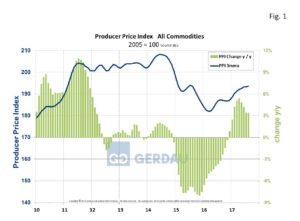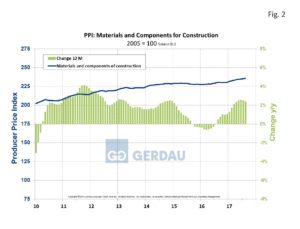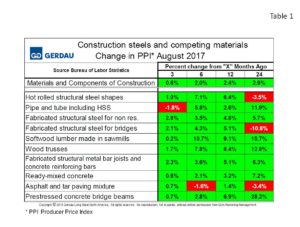Producer Price Index for Construction
The Bureau of Labor Statistics (BLS), Producer Price Index (PPI) program measures the average change over time in the selling prices received by domestic producers for their output. We have witnessed over time that this technique is excellent for measuring price inflation or deflation on construction materials and structures.
The U.S. producer prices index (PPI), for final all commodities was flat in August. On a 12 months year on year, (y/y) comparison, the all commodities PPI rose 3.4%.
 Figure 1 shows the 3MMA, PPI for all commodities. The index began declining mid-2014, bottoming-out in March 2016. Since then the trend has been higher with most econometric indicators pointing to continued higher pricing going forward.
Figure 1 shows the 3MMA, PPI for all commodities. The index began declining mid-2014, bottoming-out in March 2016. Since then the trend has been higher with most econometric indicators pointing to continued higher pricing going forward.
Figure 2  shows the 3MMA, materials and components PPI for construction. The material and construction components PPI increased by 0.2% m/m and by 0.6%, 3 months y/y. On a 12 months y/y metric, the material and construction component PPI gained 2.4%. This index has increased at a gradual pace in each of the past nine months. The material and components for non-residential construction PPI rose 0.4% m/m, 0.9%, 3 months y/y. On a 12 months y/y metric, the PPI gained 2.6%.
shows the 3MMA, materials and components PPI for construction. The material and construction components PPI increased by 0.2% m/m and by 0.6%, 3 months y/y. On a 12 months y/y metric, the material and construction component PPI gained 2.4%. This index has increased at a gradual pace in each of the past nine months. The material and components for non-residential construction PPI rose 0.4% m/m, 0.9%, 3 months y/y. On a 12 months y/y metric, the PPI gained 2.6%.
Table 1  presents a PPI comparison of construction steels and its competing materials. The data lists the PPI in percentage change terms referencing timeframes 3, 6, 12 and 24 months ago. This tells us whether or not pricing is moving up or down over time. In the case of construction materials, prices for the most part, have been increasing across the board.
presents a PPI comparison of construction steels and its competing materials. The data lists the PPI in percentage change terms referencing timeframes 3, 6, 12 and 24 months ago. This tells us whether or not pricing is moving up or down over time. In the case of construction materials, prices for the most part, have been increasing across the board.
The overall number for all materials and components of construction was up 0.6% over the past three months and up 2.4% y/y. Structural steel shapes prices are moving-up, advancing 1.0% over 3 months and by 6.4% y/y. The PPI for pipe, tube and hollow structural shapes fell of 1.8% over 3 months, but was up 2.6% y/y. The near term PPI for fabricated steel products is increasing at a higher rate than its base materials. Fabricated structural steel for non-residential construction moved up 2.8% over three months and by 4.8% y/y. Fabricated structural steel for bridges increased by a similar amount. The PPI for these components rose 2.1% over 3 months and 5.1% y/y. Fabricated bar joist and fabricated rebar, (grouped together in one category) also increased in price, up 2.3% over 3 months and up 5.1% on a y/y comparison.
The PPI for non-residential structures moved-up 0.9%, 3 months y/y and by 2,6% on a y/y comparison.
At Gerdau, we monitor the PPI which is issued monthly from the Bureau of Labor Statistics because our past analysis has led us to believe that the BLS PPI numbers measure-up to real-world pricing. We feel it is important for us and our customers to know where we are pricing-wise relative to history and how we stack-up against competing materials.

